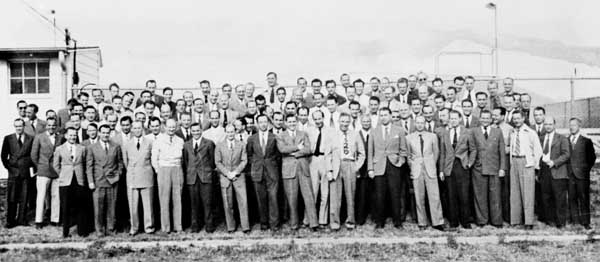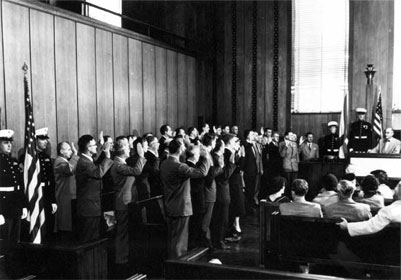by Rahnuma Ahmed

You wouldn’t think that the American government’s public commitment to bringing the “Hitlerite Huns” to justice would be accompanied by a secret agenda of “sanitizing, using, and absolving” Nazis, would you? (Earlean M. McCarrick, “American Anti-Nazism: A Cold War Casualty,” 1989). Of rewarding some as well, I must, add.
For those who haven’t heard of Operation Paperclip, here are some facts, but before presenting those, read this excerpt to be reminded of the terrible atrocities of the Holocaust,
The roundup of Jews began at 3AM? The local police, bolstered by reinforcements from the neighboring town of Zembin, surrounded the ghetto? The killing went on throughout the day?Some of the guards raped the younger women before forcing them into the pits. Heads were smashed by rifle butts, and bodies were mutilated. Autopsies conducted after the war showed that some babies, out of sheer savagery or to save ammunition, had been thrown into the pits and buried alive?children were thrown into wells and hand grenades dropped down upon them, and Byelorussian policeman commanded by SS General Franz Kushel, swung infants by the heels and smashed their heads against rocks? The SS claimed they were killing ten thousand Jews per week. ?In all, about two thirds of the approximately 375,000 Jews who lived in Byelorussia before the Nazi invasion were swallowed up by the Holocaust? Solomon Schiadow, one of the few inmates who escaped Koldichevo, later described conditions there: One day a Byelorussian caught a youngster looking at the sky as planes flew overhead, and accused the prisoner of attempting to signal enemy aircraft. The guard ordered several other Jews to hold the youth down over a table. He warned them that anyone who let go would replace the man at the table. He took out his knife and began to carve large steaks out of the living flesh of the young man, as if he were a butcher calmly working on a side of beef (from former United States Justice Department Attorney John Loftus’ book, America?s Nazi Secret (2010); quoted by Carla Stea, “Neo-Nazism…,” Global Research, January 22, 2012).
Project Paperclip — originally named Operation Overcast — was a programme of the Office of Strategic Services (OSS) to recruit Nazi scientists during and after the final stages of World War II. As a six hundred page draft report of the US Justice Department (2006) says, it was conceived “partly to prevent Nazi scientists from falling into the hands of the Soviet forces.”
Through executing it, the report says, the US government had “collaborated” with Nazi persecutors for, some of these scientists were “knowingly granted entry” into the United States.

An estimated 1,600 Nazi scientists were recruited by the US from 1945-55. Most scholars and journalists researching Operation Paperclip agree that it was the Cold War which provided the context and the impetus for the project. Professor Christopher Simpson in Blowback: America’s Recruitment of Nazis and Its Effects on the Cold War (1988) writes, the primary rationale consistently provided was that it “was of practical value to the United States in international relations”, that national security interests demanded that Nazi scientists be recruited because the rapid demobilisation of special intelligence agents had left few in army intelligence with requisite information about the USSR.
However, it was not only the Americans; the British, French and Soviets too, readily recruited Nazi scientists into their fold. It was all done secretly.
The OSS programme was executed by the Joint Intelligence Objectives Agency (JIOA), and although president Truman initially rejected the proposal, he agreed to Operation Paperclip in August 1945, with the caution that anyone found ?to have been a member of the Nazi Party, and more than a nominal participant in its activities, or an active supporter of Nazi militarism? — should be excluded.
But since this meant JIOA would have to leave out those it badly wanted, rocket scientists Wernher von Braun and Arthur Rudolph, the physician Hubertus Strughold and many others, the JIOA began working independently. It created “false employment and political biographies for the scientists” (Clarence G. Lasby et. al., Project Paperclip: German Scientists and the Cold War, 1975).
To contain potential criticism, colonel E. W. Gruhn, director, JIOA, organised press visits to meet “representative German scientists” whom he described as “comparable to Prof. Einstein.” Einstein himself strongly objected to Truman about permitting German scientists to enter America. So did a few American officials, the strongest to do so, Samuel Maus (State Department), was soon posted elsewhere (Tom Bower, The Paperclip Conspiracy, 1988).
The Justice Department report — which provides evidence of more than two dozen of the most notorious cases — chronicles the assistance provided by CIA officials to Baron Otto von Bolschwing. He was an associate of Adolf Eichmann who was one of the first to develop plans of “purg[ing] Germany of the Jews.” In 1945, Von Bolschwing enlisted as a CIC (Counter Intelligence Corps) informer for the Americans, by 1947, CIA agents in Vienna, Austria, had “recognized his skills and recruited him for special work on some of the most sensitive missions the agency has ever undertaken. These included running secret agents behind the Iron Curtain and even spying on Gehlen himself on behalf of the Americans” (Simpson). The Justice Department report mentions how CIA officials debated in a chain of memos what to do if Von Bolschwing was confronted about his past, whether he should deny any Nazi affiliation or “explain it away on the basis of extenuating circumstances.”
Walter Haeussermann — a leading member of Nazi SS Colonel Werner von Braun’s team of rocket scientists — worked for the Nazis at Peenem?nde, Germany (1939-42). He helped develop the V-1 “flying bomb” and supersonic V-2 rockets. These were later deployed by Hitler in London and Antwerp, Belgium. “The V-1 attacks caused 22,892 civilian casualties (about 8,000 dead) and damaged over one million homes, while the V-2 killed 2,541 civilians and injured 5,923.”
Brought to the United States after World War II, he helped develop U.S. guided missiles; he was later made head of the Marshall Space Flight Centre (Dougal MacDonald, December 29, 2010).
Arthur Rudolph, a loyal Nazi Party member, was operations director at Mittelwerk, an underground factory which produced Nazi weapons. It depended on slave labour from Dora, a concentration camp nearby, where 60,000 slave labourers from 21 countries, were “treated with extreme cruelty, causing illness, injuries and death.” An estimated 25,000 slave labourers died, 9,000 from exhaustion and collapse; 350 were hanged; many went insane from the machinery vibrations.
Rudolph was brought to the US in 1945 for his experience of rocket making. He received the Exceptional Civilian Service award in 1960, the highest civilian award in the US Army, for his management of the Pershing missile programme. In 1969, he received NASA’s Distinguished Service Award for his work as director of the project which landed American astronauts on the moon. He left the US in 1984, not wanting to face charges as a Nazi war criminal; despite public outcry, his medal has not been withdrawn.
Hubertus Strughold, head of Nazi Air Force Institute for Aviation Medicine, conducted experiments at Dachau concentration camp, inmates were tortured and killed by being forced to drink salt water and suffer freezing water temperatures and high air pressures.
He began his US career in Texas, at the School of Aviation Medicine. The Space Medicine Branch initiated the ?Hubertus Strughold Award? in 1963, given each year for the greatest achievement in space medicine. The award is still given.
Operation Paperclip ran until as late as 1973; some suspect that some of its programmes still remain active.
The recruitment of Nazi scientists remains a hidden and dirty chapter of US history, officially unacknowledged.
Recently the US-links-to-Nazism story took another strange turn when a UN resolution (“Inadmissibility of Certain Practices That Contribute to Fuelling Contemporary Forms of Racism, Racial Discrimination, Xenophobia and Related Intolerance”) calling for the condemnation and outlawing of all forms of racism including neo-Nazism, was rejected by the US, UK and the rest of Europe on December 19, 2011.
It was adopted by a majority vote of 134 (including Bangladesh); among its co-sponsors were Iran, Syria, the Russian Federation, Venezuela etc. It was “extraordinary”, comments Carla Stea, because it united Israel, Iran and Syria in its support.
The resolution,
4. ?Expresses deep concern about the glorification of the Nazi movement and former members of the Waffen SS organization, including by erecting monuments and memorials and holding public demonstrations in the name of the glorification of the Nazi past, the Nazi movement and neo-Nazism…
5. ?Expresses concern at recurring attempts to desecrate or demolish monuments erected in remembrance of those who fought against Nazism during the Second World War, as well as to unlawfully exhume or remove the remains of such persons…
8. Stresses that the practices described above do injustice to the memory of the countless victims of crimes against humanity committed in the Second World War, in particular those committed by the SS organizations and those who fought against the anti-Hitler coalition and collaborated with the Nazi movement, and poison the minds of young people…
Stea, most importantly, reminds us that not only were six million Jews exterminated by the Nazis, but that approximately thirty million Soviet nationals had been exterminated by the end of World War II, two-thirds of them civilians.
Why did the US, Britain and Europe cast this “extraordinary” vote against a UN resolution which declares disseminating ideas of racial superiority or hatred as illegal and, prohibits organisations and public authorities from inciting racial discrimination?
Modest Kolerov, human rights activist, when asked why the US was likely to go against it, and why the EU was likely to toe the US line, spoke of the rise of Nazism in the former Soviet Baltic republics. Lithuania, Latvia and Estonia had entered the EU not so long ago, they receive active backing from the US for “integration into Western Europe.” Glorifying Nazi collaborators has nearly become “official policy” in these newly-independent states, even high-ranking politicians take part in the Nazi parades. This has often been condemned by Russia, the drafters of the UN resolution (Vyacheslav Solovyov, “Why the US and the EU back Baltic Nazis,” Global Research, November 12, 2010).
But others such as Mark Watson thinks it has to do with racism within white western nations. Voting for the UN resolution would have meant the end of all far right organisations such as the British National Party (UK), the Ku Klux Klan (US). It would have spelt the end of politicians and political parties being able to continue using immigration as “an excuse for society’s problems.” The end of police racist stop-and-searches. Of the media, publishing anti-immigration stories and alarming statistics about the births rates of non-whites (“America and Britain vote against UN racism and Nazi resolution,” January 23, 2012).
The mainstream media in western countries has largely ignored this extraordinary vote. After all, what reasonable explanation could they possibly offer?
Raped women. Heads smashed. Bodies mutilated. Flesh carved.
Holocaust’s atrocities, spoken of only when it suits American/western leaders.
Published in New Age, Monday, August 8, 2012.

really interesting article, seems the nazis still exist and very active ?!
double standards!!!